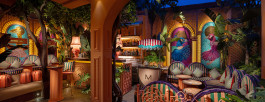
On a warm summer evening in August, we meet Guido Spinello at Nunziatina, his restaurant in Taormina.
In a quiet private room filled with red velvet, votive hearts, and the scent of jasmine, the conversation unfolds like the island itself — layered, warm, and alive.
Born and raised here, Guido is one of the creative forces behind Bella Repertoire, the hospitality group shaping some of Taormina’s most distinctive destinations: the ever-evolving cocktail institution Morgana, the nostalgic-yet-refined Nunziatina, and the cultural travel platform Sicily Lifestyle.
Together with his partners Christian Liistro, Salvatore Musumeci, and Dario Pandolfo, and with the culinary vision of Chef Dionisio Randazzo, Guido creates experiences where Sicilian memory, design, and contemporary hospitality intertwine.
In this conversation, he speaks about identity, tradition, risk, and the vision of a Sicily that continues to reinvent itself.

— You’ve created two iconic places in Taormina — Morgana and Nunziatina — that feel both deeply Sicilian and incredibly cosmopolitan. What does “Sicilian identity” mean to you today?
— First of all, we created them. Nothing we do exists without the group — Bella Repertoire — a family of creative minds and friends. Christian, Salvatore, Dario, Dionisio, and I started with the idea of building a new kind of hospitality for Sicily. One that feels elegant but never pretentious, rooted in our culture yet open to the world.
For us, luxury has nothing to do with price. Luxury means time, atmosphere, and emotion — the experience you take with you. That’s what we aim to create in every project, from a cocktail to an entire space.
— How has your own personal journey shaped your relationship to the island, its traditions, and its future?
— Sicily has this constant dialogue between the past and the future. You can’t separate them — they’re both essential. My connection to the island is emotional and professional at once. I grew up here, I left for a while, I saw how hospitality works elsewhere, and then I came back with new eyes.
For me, the key is to protect the soul — the Sicilian way of welcoming — while giving it a contemporary rhythm. We need to keep evolving, but never forget where we come from.
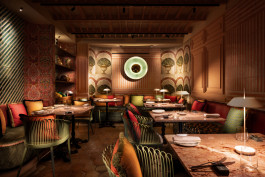
— Nunziatina is rooted in nostalgia — a tribute to Sicilian grandmothers — but elevated through contemporary design and cuisine. How did the concept come to life?
— The story of Nunziatina started with a house. The building itself belonged to a lady called Signora Nunziatina, who still lives upstairs. We loved the idea that this place had a soul before we even arrived. So the restaurant became a reinterpretation of a Sicilian home — a space filled with affection, memories, and family spirit.
Our goal was to create something warm and feminine — a place that feels intimate, almost like being at your nonna’s table, but with a touch of refined design. The red velvet, the votive hearts, the garden terrace — every element tells a story.
— Tell us about your collaboration with Chef Dionisio Randazzo. How does his cooking translate the story you’re telling with the space?
— Dionisio is one of the most talented chefs I know. He understands Sicily not only as a place but as an emotion. When he cooks, he tells a story — a bridge between memory and modernity.
Our collaboration is built on trust and constant dialogue. We talk about ingredients, about family recipes, about feelings. He creates the flavors that match the spirit of Nunziatina — genuine, soulful, elegant. One of my favorite dishes is DoReMi, his twist on a 17th-century recipe from Messina — insalata russa with scampi. It’s both traditional and surprising, and every bite reminds you where you are.
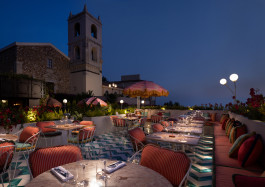
— The restaurant has layers: a baroque salon, a garden terrace, a kitchen temple. How did you design the guest journey through the space?
— We wanted the guest to feel like they’re walking through a story. You enter a baroque living room, then pass into a sunlit garden, and end up near the kitchen — which we call our temple.
Everything revolves around atmosphere. The design by Salvatore Musumeci combines old-world charm with modern rhythm. You hear quiet music, smell the jasmine from outside, and see candles flicker against antique walls. It’s not just decoration — it’s emotion.
— There’s a lot of symbolism at Nunziatina — votive hearts, sacred iconography, red velvet. Is that religious, romantic, nostalgic?
— It’s all of them. Sicilian life has always mixed religion, romance, and nostalgia. These symbols represent devotion — not only to faith but to family, to tradition, to love.
— Who is the ideal guest at Nunziatina — someone curious, stylish, nostalgic … ?
— People who come with curiosity. Those who want to live an experience, not just have dinner. Our guests often tell us they feel like they’re in a film — but one that feels real, not staged.
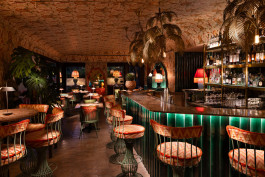
— Madonna once visited Nunziatina, and the story quickly went viral. What did that moment mean to you — not just as a restaurateur, but as a Sicilian?
— That night gave us incredible energy. We had just opened Nunziatina, and the restaurant wasn’t even fully operating yet. One afternoon, I got a call from our friend Lorenzo, the manager of a nearby hotel. He said, “Guido, there’s a special guest looking for a place to celebrate her birthday. I told her your restaurant is perfect.”
I laughed — we hadn’t even tested the kitchen.
At 1 p.m., her team arrived — assistants, bodyguards, family — to look around. They said, “Perfect. Dinner for 28 people. Tonight.” We had three hours to make it happen. The team flew into action. We set tables, brought flowers, rearranged furniture, opened wine, and Dionisio created a menu from scratch.
By evening, the room glowed with candles and music. And then she walked in — Madonna herself — with her children, her friends, her energy. It was surreal. She laughed, danced, ate everything, loved Dionisio’s food, and hugged half the team before leaving.
At midnight, she posted about it — and suddenly, the whole world was looking at our little Sicilian restaurant. It wasn’t just luck; it was a moment that proved how far Sicilian hospitality can go when it comes from the heart. It made us believe even more in what we do.
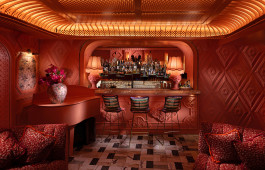
— Morgana reinvents itself every season — visually, emotionally, even spiritually. Why this constant transformation? Is Sicily a place that inspires change?
— “Morgana” itself means mirage — something that changes shape depending on where you stand. That’s how we see the bar. It’s not just a place to drink; it’s a living artwork. Every season we change everything — design, lighting, scent, sound, and menu.
We could have opened ten Morganas by now, but we prefer one that transforms. This constant rebirth keeps us and our guests inspired. Thanks to Salvatore Musumeci, who designs each new concept, Morgana feels like stepping into a different dream every year.
— From scent to light to sound, Morgana feels like a designed dream. What’s your creative process behind crafting those layered experiences?
— It starts with travel and conversation. We observe colors, moods, and sensations — sometimes from nature, sometimes from art or music. Then we sit down as a team, sketch ideas, and imagine how people should feel when they walk in.
This year’s theme is a mix of oriental elegance and Sicilian sensuality — pinks, silks, lights that feel like sunset. It’s playful but immersive, something that touches all five senses.
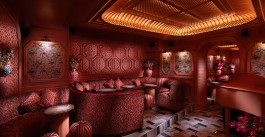
— Morgana’s cocktail menu is almost like a mood board — each drink feels like it has its own backstory. What makes it so iconic?
— Our menu changes every year, just like the space. This season it travels the world — from Mexico to Japan, from Sicily to New York — collecting flavors and ideas. Every cocktail has a story. My personal favorite is Malandrina, one of our earliest signatures. It’s strong, mysterious, and elegant — like Sicily itself.
— What’s the boldest creative risk you’ve taken at Morgana that actually worked?
— Painting the entire club pink. People thought we were crazy. But we love risks — Morgana is built on them. The beauty of it is that every season is a risk. You never know if people will love the new design, but we keep going, and that’s what keeps it alive.
— What do you hope a guest feels or remembers after a night at Morgana?
— That they’ve lived something special. Great cocktails, yes — but also atmosphere, service, music, design. I want people to walk out thinking, “That was more than a night out — that was a story.”
— After White Lotus, Taormina became globally iconic. What’s your view on this wave of “cinematic tourism”?
— Like The Godfather once did, The White Lotus changed how people see Sicily. It showed our light, our architecture, our mystery. People realized Sicily isn’t just history — it’s beauty, humor, and humanity.
— Has the international attention changed your visitors? What do tourists still get wrong — or right — about Sicily?
— Now, we see travelers who are more curious and conscious. They want to experience the real island — not clichés, but people, food, and culture. Sicily is learning to welcome that curiosity with pride.
— Would you like to collaborate more with artists, choreographers, or fashion curators in Sicily? What kind of cultural events do you think the island still needs?
— Absolutely. I’d love to see a large-scale contemporary art festival in Taormina — something that connects our ancient spaces with modern creativity. Sicily has the landscape, the history, and the talent. It just needs the platform.
— What kind of Sicily do you want to leave behind — for locals and for the world?
— The real Sicily — where you can stay in a five-star hotel and still eat homemade pasta in a village. A place that’s open, authentic, and full of contrast. That’s what makes it unforgettable.
Sicily has always reinvented itself without losing its soul — layer by layer, influence by influence. But for the island to keep evolving, it needs people who stay, create, and see its potential with clear eyes. Guido Spinello and his team at Bella Repertoire are among those shaping what modern Taormina looks and feels like — connecting heritage with imagination.
Their work keeps the town’s magic alive, drawing in new visitors, stories, and ideas that make Taormina glow a little brighter each season. And perhaps that’s what this island needs most: people who stay to dream, create, and build — people like Guido, who remind us why it’s so easy to fall in love with Sicily on one summer evening.
Related Articles:

On a warm summer evening in August, we meet Guido Spinello at Nunziatina, his restaurant in Taormina.
In a quiet private room filled with red velvet, votive hearts, and the scent of jasmine, the conversation unfolds like the island itself — layered, warm, and alive.
Born and raised here, Guido is one of the creative forces behind Bella Repertoire, the hospitality group shaping some of Taormina’s most distinctive destinations: the ever-evolving cocktail institution Morgana, the nostalgic-yet-refined Nunziatina, and the cultural travel platform Sicily Lifestyle.
Together with his partners Christian Liistro, Salvatore Musumeci, and Dario Pandolfo, and with the culinary vision of Chef Dionisio Randazzo, Guido creates experiences where Sicilian memory, design, and contemporary hospitality intertwine.
In this conversation, he speaks about identity, tradition, risk, and the vision of a Sicily that continues to reinvent itself.

— You’ve created two iconic places in Taormina — Morgana and Nunziatina — that feel both deeply Sicilian and incredibly cosmopolitan. What does “Sicilian identity” mean to you today?
— First of all, we created them. Nothing we do exists without the group — Bella Repertoire — a family of creative minds and friends. Christian, Salvatore, Dario, Dionisio, and I started with the idea of building a new kind of hospitality for Sicily. One that feels elegant but never pretentious, rooted in our culture yet open to the world.
For us, luxury has nothing to do with price. Luxury means time, atmosphere, and emotion — the experience you take with you. That’s what we aim to create in every project, from a cocktail to an entire space.
— How has your own personal journey shaped your relationship to the island, its traditions, and its future?
— Sicily has this constant dialogue between the past and the future. You can’t separate them — they’re both essential. My connection to the island is emotional and professional at once. I grew up here, I left for a while, I saw how hospitality works elsewhere, and then I came back with new eyes.
For me, the key is to protect the soul — the Sicilian way of welcoming — while giving it a contemporary rhythm. We need to keep evolving, but never forget where we come from.

— Nunziatina is rooted in nostalgia — a tribute to Sicilian grandmothers — but elevated through contemporary design and cuisine. How did the concept come to life?
— The story of Nunziatina started with a house. The building itself belonged to a lady called Signora Nunziatina, who still lives upstairs. We loved the idea that this place had a soul before we even arrived. So the restaurant became a reinterpretation of a Sicilian home — a space filled with affection, memories, and family spirit.
Our goal was to create something warm and feminine — a place that feels intimate, almost like being at your nonna’s table, but with a touch of refined design. The red velvet, the votive hearts, the garden terrace — every element tells a story.
— Tell us about your collaboration with Chef Dionisio Randazzo. How does his cooking translate the story you’re telling with the space?
— Dionisio is one of the most talented chefs I know. He understands Sicily not only as a place but as an emotion. When he cooks, he tells a story — a bridge between memory and modernity.
Our collaboration is built on trust and constant dialogue. We talk about ingredients, about family recipes, about feelings. He creates the flavors that match the spirit of Nunziatina — genuine, soulful, elegant. One of my favorite dishes is DoReMi, his twist on a 17th-century recipe from Messina — insalata russa with scampi. It’s both traditional and surprising, and every bite reminds you where you are.

— The restaurant has layers: a baroque salon, a garden terrace, a kitchen temple. How did you design the guest journey through the space?
— We wanted the guest to feel like they’re walking through a story. You enter a baroque living room, then pass into a sunlit garden, and end up near the kitchen — which we call our temple.
Everything revolves around atmosphere. The design by Salvatore Musumeci combines old-world charm with modern rhythm. You hear quiet music, smell the jasmine from outside, and see candles flicker against antique walls. It’s not just decoration — it’s emotion.
— There’s a lot of symbolism at Nunziatina — votive hearts, sacred iconography, red velvet. Is that religious, romantic, nostalgic?
— It’s all of them. Sicilian life has always mixed religion, romance, and nostalgia. These symbols represent devotion — not only to faith but to family, to tradition, to love.
— Who is the ideal guest at Nunziatina — someone curious, stylish, nostalgic … ?
— People who come with curiosity. Those who want to live an experience, not just have dinner. Our guests often tell us they feel like they’re in a film — but one that feels real, not staged.

— Madonna once visited Nunziatina, and the story quickly went viral. What did that moment mean to you — not just as a restaurateur, but as a Sicilian?
— That night gave us incredible energy. We had just opened Nunziatina, and the restaurant wasn’t even fully operating yet. One afternoon, I got a call from our friend Lorenzo, the manager of a nearby hotel. He said, “Guido, there’s a special guest looking for a place to celebrate her birthday. I told her your restaurant is perfect.”
I laughed — we hadn’t even tested the kitchen.
At 1 p.m., her team arrived — assistants, bodyguards, family — to look around. They said, “Perfect. Dinner for 28 people. Tonight.” We had three hours to make it happen. The team flew into action. We set tables, brought flowers, rearranged furniture, opened wine, and Dionisio created a menu from scratch.
By evening, the room glowed with candles and music. And then she walked in — Madonna herself — with her children, her friends, her energy. It was surreal. She laughed, danced, ate everything, loved Dionisio’s food, and hugged half the team before leaving.
At midnight, she posted about it — and suddenly, the whole world was looking at our little Sicilian restaurant. It wasn’t just luck; it was a moment that proved how far Sicilian hospitality can go when it comes from the heart. It made us believe even more in what we do.

— Morgana reinvents itself every season — visually, emotionally, even spiritually. Why this constant transformation? Is Sicily a place that inspires change?
— “Morgana” itself means mirage — something that changes shape depending on where you stand. That’s how we see the bar. It’s not just a place to drink; it’s a living artwork. Every season we change everything — design, lighting, scent, sound, and menu.
We could have opened ten Morganas by now, but we prefer one that transforms. This constant rebirth keeps us and our guests inspired. Thanks to Salvatore Musumeci, who designs each new concept, Morgana feels like stepping into a different dream every year.
— From scent to light to sound, Morgana feels like a designed dream. What’s your creative process behind crafting those layered experiences?
— It starts with travel and conversation. We observe colors, moods, and sensations — sometimes from nature, sometimes from art or music. Then we sit down as a team, sketch ideas, and imagine how people should feel when they walk in.
This year’s theme is a mix of oriental elegance and Sicilian sensuality — pinks, silks, lights that feel like sunset. It’s playful but immersive, something that touches all five senses.

— Morgana’s cocktail menu is almost like a mood board — each drink feels like it has its own backstory. What makes it so iconic?
— Our menu changes every year, just like the space. This season it travels the world — from Mexico to Japan, from Sicily to New York — collecting flavors and ideas. Every cocktail has a story. My personal favorite is Malandrina, one of our earliest signatures. It’s strong, mysterious, and elegant — like Sicily itself.
— What’s the boldest creative risk you’ve taken at Morgana that actually worked?
— Painting the entire club pink. People thought we were crazy. But we love risks — Morgana is built on them. The beauty of it is that every season is a risk. You never know if people will love the new design, but we keep going, and that’s what keeps it alive.
— What do you hope a guest feels or remembers after a night at Morgana?
— That they’ve lived something special. Great cocktails, yes — but also atmosphere, service, music, design. I want people to walk out thinking, “That was more than a night out — that was a story.”
— After White Lotus, Taormina became globally iconic. What’s your view on this wave of “cinematic tourism”?
— Like The Godfather once did, The White Lotus changed how people see Sicily. It showed our light, our architecture, our mystery. People realized Sicily isn’t just history — it’s beauty, humor, and humanity.
— Has the international attention changed your visitors? What do tourists still get wrong — or right — about Sicily?
— Now, we see travelers who are more curious and conscious. They want to experience the real island — not clichés, but people, food, and culture. Sicily is learning to welcome that curiosity with pride.
— Would you like to collaborate more with artists, choreographers, or fashion curators in Sicily? What kind of cultural events do you think the island still needs?
— Absolutely. I’d love to see a large-scale contemporary art festival in Taormina — something that connects our ancient spaces with modern creativity. Sicily has the landscape, the history, and the talent. It just needs the platform.
— What kind of Sicily do you want to leave behind — for locals and for the world?
— The real Sicily — where you can stay in a five-star hotel and still eat homemade pasta in a village. A place that’s open, authentic, and full of contrast. That’s what makes it unforgettable.
Sicily has always reinvented itself without losing its soul — layer by layer, influence by influence. But for the island to keep evolving, it needs people who stay, create, and see its potential with clear eyes. Guido Spinello and his team at Bella Repertoire are among those shaping what modern Taormina looks and feels like — connecting heritage with imagination.
Their work keeps the town’s magic alive, drawing in new visitors, stories, and ideas that make Taormina glow a little brighter each season. And perhaps that’s what this island needs most: people who stay to dream, create, and build — people like Guido, who remind us why it’s so easy to fall in love with Sicily on one summer evening.
Related Articles:
You need to load content from reCAPTCHA to submit the form. Please note that doing so will share data with third-party providers.
More InformationYou need to load content from Turnstile to submit the form. Please note that doing so will share data with third-party providers.
More InformationYou are currently viewing a placeholder content from Facebook. To access the actual content, click the button below. Please note that doing so will share data with third-party providers.
More InformationYou are currently viewing a placeholder content from Instagram. To access the actual content, click the button below. Please note that doing so will share data with third-party providers.
More InformationYou need to load content from hCaptcha to submit the form. Please note that doing so will share data with third-party providers.
More InformationYou need to load content from reCAPTCHA to submit the form. Please note that doing so will share data with third-party providers.
More InformationYou are currently viewing a placeholder content from Turnstile. To access the actual content, click the button below. Please note that doing so will share data with third-party providers.
More InformationYou are currently viewing a placeholder content from X. To access the actual content, click the button below. Please note that doing so will share data with third-party providers.
More Information